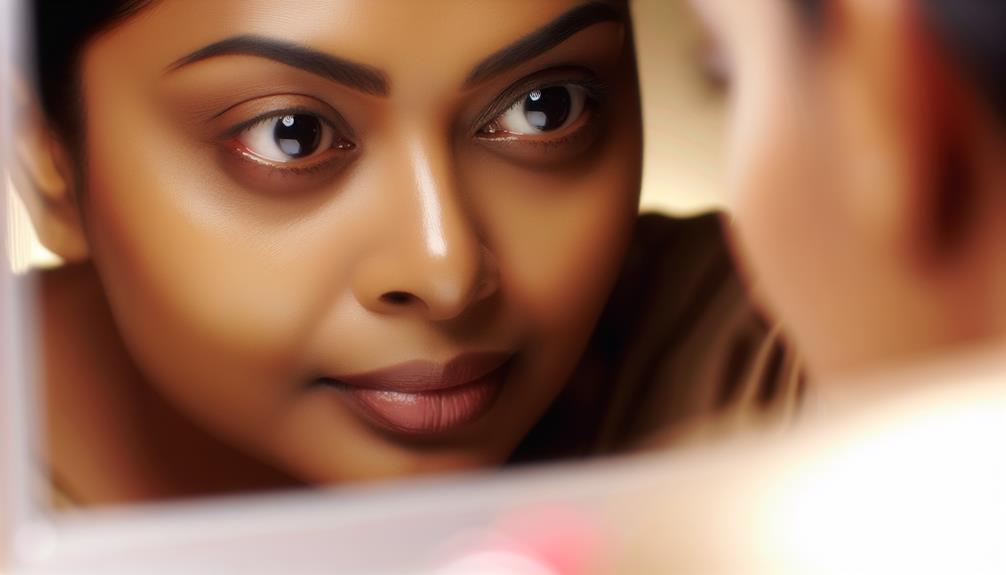The cost of under-eye fillers typically ranges from $600 to $1,500 per session, influenced by factors such as practitioner expertise, product type, and geographical location. These fillers can effectively reduce dark circles, restore volume, and improve skin texture, contributing to a more youthful appearance and increased confidence. However, they require maintenance, with results lasting approximately six months to a year. While many find the immediate aesthetic benefits worth the investment, it's essential to weigh personal budget, potential side effects, and treatment expectations. Understanding these nuances will enhance your decision-making process regarding this popular cosmetic procedure.
Key Takeaways
- Under-eye fillers cost between $600 to $1,500 per session, influenced by factors such as product type and practitioner expertise.
- Benefits include reduced dark circles, improved skin texture, and enhanced aesthetic appearance, often leading to increased self-confidence.
- Fillers offer immediate results, unlike alternatives like chemical peels or lifestyle changes that provide gradual improvements.
- Ongoing maintenance is required, with effects lasting from six months to a year, impacting long-term investment considerations.
- Consultation with qualified professionals is crucial for minimizing risks and enhancing satisfaction with treatment outcomes.
Understanding Under-Eye Fillers
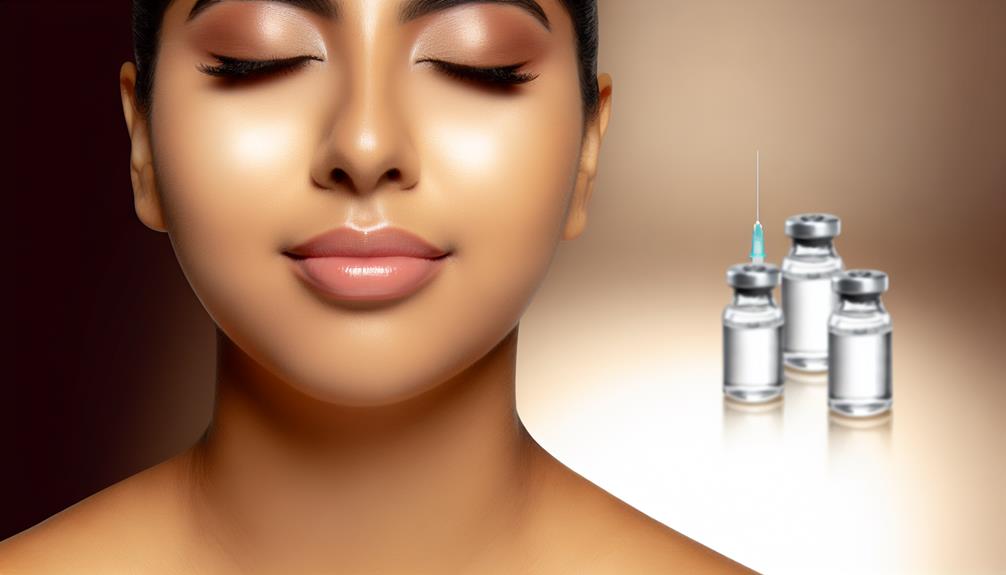
Under-eye fillers have become increasingly popular in the domain of aesthetic treatments, with countless individuals seeking solutions for dark circles, hollowness, and signs of aging. These specialized injectables offer a non-surgical approach to rejuvenating the delicate under-eye area, creating a more youthful and vibrant appearance. Many people, including celebrities, have shared their experiences with aesthetic procedures, highlighting the impact of these treatments on their self-esteem and overall confidence Bruce Willis' health journey.
There are various filler types available, primarily hyaluronic acid-based, which is favored for its natural compatibility with the body and ability to retain moisture. Other options include calcium hydroxylapatite and poly-L-lactic acid, each offering unique benefits tailored to individual needs. The choice of filler type often depends on factors such as skin type, desired results, and the practitioner's expertise.
Treatment duration typically ranges from 30 minutes to an hour, allowing for a quick and convenient experience. Patients may observe immediate results, with ideal outcomes developing over a few days as swelling subsides. While the longevity of effects can vary, most fillers last between six months to a year, prompting some individuals to contemplate regular maintenance sessions. Understanding these aspects can empower prospective clients to make informed decisions about their aesthetic journey, fostering a sense of belonging within a community seeking enhanced beauty.
Factors Affecting Cost
The cost of under-eye fillers is influenced by a variety of factors that prospective clients should consider when planning their treatment. One significant factor is the injectable types available, which can vary in price based on their formulation and brand reputation. Hyaluronic acid fillers, for example, are popular but may come at different price points depending on their specific properties and how they integrate with the skin. Additionally, clients seeking remote customer service jobs may find that investing in aesthetic treatments like fillers can enhance their confidence in a competitive job market.
Additionally, treatment frequency plays a vital role in determining overall costs. Many clients require follow-up sessions to maintain results, and the frequency of these treatments can add to the long-term investment of under-eye fillers. It's important to assess how often you'll need touch-ups based on your individual needs and the longevity of the chosen injectable type.
The expertise of the practitioner also impacts cost; experienced providers often charge higher fees due to their skill and ability to deliver peak results. Finally, geographical location cannot be overlooked, as prices can vary substantially from one region to another. Understanding these factors helps clients make informed decisions about their under-eye filler journey and guarantee they choose the best option for their aesthetic goals.
Average Price Range
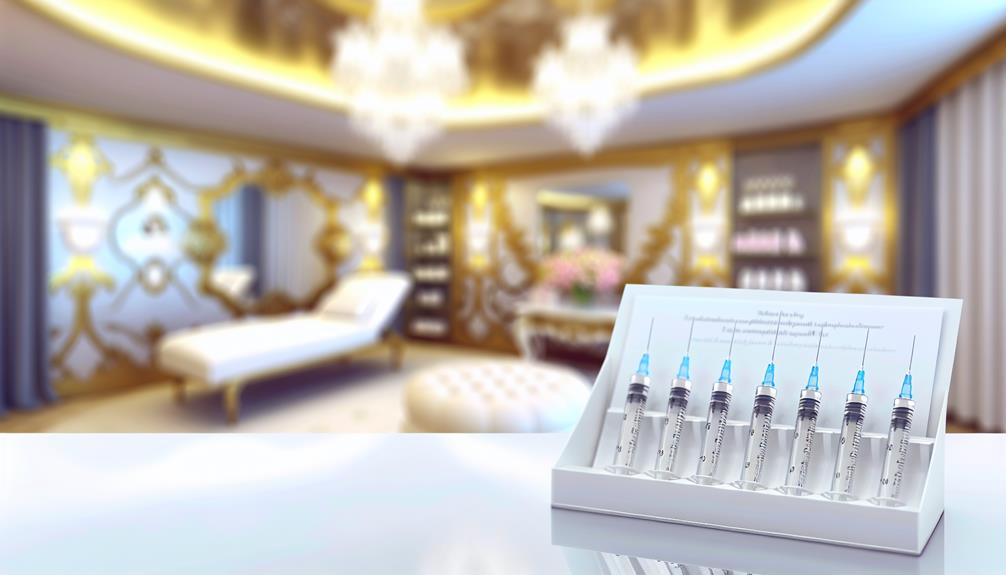
A typical price range for under-eye fillers generally falls between $600 and $1,500 per treatment session. These average costs can vary considerably based on numerous factors, including the practitioner's experience, the specific product used, and the treatment location. Urban centers and upscale clinics often command higher fees, reflecting the demand for premium services and experienced professionals. Additionally, individuals seeking extensive healthcare services, such as those offered at local clinics like Syracuse Community Health Center, may benefit from consultations that help inform their cosmetic choices.
In addition to geographical differences, the type of filler selected can also influence the overall price. Hyaluronic acid-based fillers, for instance, are widely used and may come at varying price points depending on the brand and formulation. Patients should also consider the potential for additional costs, such as follow-up appointments or touch-ups, which may be necessary to maintain desired results.
When evaluating the investment in under-eye fillers, it is essential to weigh the average costs against the qualifications of the provider and the quality of the products used. By doing so, patients can confirm they make informed decisions that align with their aesthetic goals and budget. Ultimately, understanding the average price range helps individuals navigate the nuances of this popular cosmetic procedure with greater confidence.
Benefits of Under-Eye Fillers
Under-eye fillers offer numerous benefits that can markedly enhance one's overall appearance. By effectively reducing dark circles and improving skin texture, these treatments contribute to a more youthful and refreshed look. Additionally, similar to how unlocking academic success can elevate performance, the aesthetic enhancement provided by fillers can boost confidence, making them a popular choice for individuals seeking to rejuvenate their under-eye area.
Enhanced Aesthetic Appearance
Fillers specifically designed for the under-eye area can greatly enhance one's aesthetic appearance by addressing common concerns such as dark circles, hollowness, and fine lines. By restoring lost volume, these fillers contribute to a more youthful glow, allowing individuals to present their best selves confidently. The transformation is often subtle but effective, creating an improvement that enhances overall facial harmony.
The results of under-eye fillers not only mitigate signs of aging but also promote aesthetic balance. A well-proportioned face is often perceived as more attractive, and addressing under-eye issues can effectively achieve this. Many people find that when they feel good about their appearance, their self-esteem flourishes, leading to greater engagement in social situations and deeper connections with others.
Moreover, achieving a refreshed look can positively impact personal and professional interactions. Individuals report feeling more approachable and energized, fostering a sense of belonging within their communities. Ultimately, the investment in under-eye fillers can yield significant returns, enhancing not just physical appearance, but also emotional well-being by fostering confidence and self-acceptance. In this way, under-eye fillers serve as a powerful tool for aesthetic enhancement and personal empowerment.
Reduced Dark Circles
One of the most significant benefits of utilizing fillers in the under-eye region is their ability to effectively reduce the appearance of dark circles. Many individuals struggle with this concern, often seeking dark circle remedies that may not yield satisfactory results. Under-eye fillers provide a more immediate and visible solution, enhancing a person's overall appearance and boosting self-confidence.
The effectiveness of fillers lies in their capacity to restore volume and diminish shadows created by hollowing under the eyes. While lifestyle changes such as improved sleep and hydration can help, they may not always suffice for persistent dark circles. Fillers offer a targeted approach that addresses the issue directly.
To illustrate the differences between various methods of addressing dark circles, consider the following table:
| Method | Effectiveness |
|---|---|
| Under-Eye Fillers | Immediate reduction |
| Topical Creams | Temporary relief |
| Lifestyle Changes | Long-term improvement |
Improved Skin Texture
The application of dermal fillers in the under-eye area not only addresses dark circles but also greatly enhances skin texture. This improvement is primarily attributed to the fillers' ability to boost hydration levels and stimulate collagen production. As we age, the delicate skin beneath our eyes can become thinner and less resilient, leading to a dull and uneven appearance. Under-eye fillers restore volume and provide a smoother surface, resulting in a revitalized look.
Enhancing skin texture is particularly beneficial for individuals seeking a more youthful and vibrant appearance without invasive procedures. By replenishing lost volume, fillers effectively address fine lines and crepiness, allowing the skin to regain its natural elasticity and suppleness. Additionally, the increased hydration levels contribute to a plumper and more radiant complexion, further enhancing overall facial harmony.
For those who desire to feel more confident and belong to a community that values self-care, investing in under-eye fillers can be a transformative experience. Ultimately, the benefits of improved skin texture extend beyond aesthetics; they foster a sense of renewed self-esteem and well-being, reinforcing the notion that self-investment is a pathway to belonging and empowerment.
Risks and Considerations
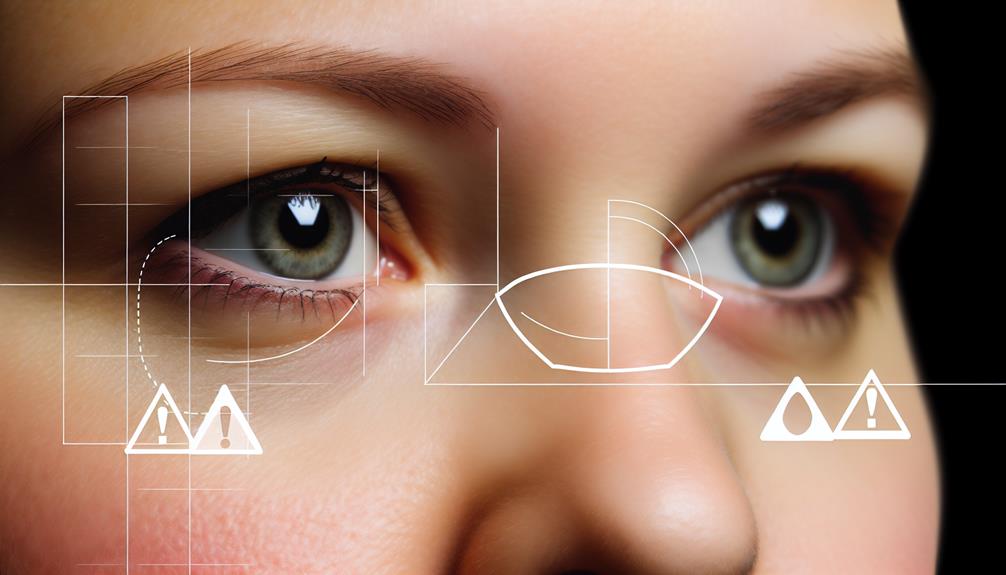
While under-eye fillers can enhance appearance, it is essential to take into account potential side effects such as swelling, bruising, or allergic reactions that may occur. As with any cosmetic procedure, it is important to be informed about the brand policies and ethical considerations surrounding the products being used, including their support for various causes. Additionally, patients should be aware of the long-term commitments associated with maintenance treatments, as the effects are not permanent and can lead to ongoing costs. Understanding these risks is vital for making an informed decision regarding the use of under-eye fillers.
Potential Side Effects
Numerous individuals considering under-eye fillers may not fully understand the potential side effects associated with the procedure. While many experience excellent results, it is vital to be aware of the risks involved, which may affect your overall satisfaction.
| Side Effect | Description | Management Tips |
|---|---|---|
| Bruising Risks | Minor bruising can occur post-injection. | Ice the area immediately after |
| Injection Pain | Some discomfort may arise during the process. | Communicate with your injector |
| Swelling Duration | Swelling is common and can last for days. | Keep your head elevated |
| Allergic Reactions | Rare, but potential allergic responses exist. | Consult your injector beforehand |
| Treatment Longevity | Results can vary, typically lasting 6-12 months. | Schedule follow-up appointments |
Understanding these potential side effects will help you make an informed decision. Proper consultation with a qualified professional can minimize bruising risks and injection pain while addressing any concerns about allergic reactions and swelling duration. Ultimately, the balance between risk and benefit is essential for a successful treatment experience, fostering a sense of community among those seeking aesthetic enhancement.
Long-Term Commitments
For those contemplating under-eye fillers, understanding the long-term commitments associated with this cosmetic procedure is paramount. The commitment duration for under-eye fillers generally ranges from six months to two years, depending on the type of filler used and individual factors such as metabolism and skin type. This necessitates a thoughtful approach to financial planning, as repeat treatments can accumulate significant costs over time.
Moreover, it is essential to recognize that while fillers can enhance appearance, they also require a commitment to ongoing maintenance. Patients should consider their long-term aesthetic goals and whether they are prepared for the potential need for subsequent treatments. Additionally, there may be risks involved, such as changes in skin elasticity or the possibility of requiring corrective procedures.
Engaging with a qualified practitioner can provide valuable insights into the realistic outcomes and care required. Ultimately, the decision to invest in under-eye fillers should align with personal values, lifestyle, and budget, fostering a sense of community among those who prioritize self-care and beauty enhancement. Balancing these factors will help you make an informed choice that supports your long-term aesthetic journey.
Comparing Alternatives
When considering under-eye fillers, patients often explore various alternatives that can achieve similar aesthetic outcomes. Non-surgical alternatives, such as chemical peels or laser treatments, offer options to rejuvenate the under-eye area without the need for injections. These methods can improve skin texture and pigmentation, potentially reducing the appearance of dark circles and fine lines. However, they may require multiple sessions to yield noticeable results.
Natural remedies are also gaining popularity among individuals seeking gentler solutions. Ingredients like hyaluronic acid serums, vitamin C, and retinol can effectively hydrate and brighten the under-eye region, promoting a healthier appearance. Additionally, lifestyle changes such as improved hydration, sleep, and a balanced diet can markedly impact skin vitality, making a compelling case for holistic approaches.
While under-eye fillers provide immediate results, exploring these alternatives can offer a more gradual enhancement, appealing to those hesitant about more invasive procedures. Ultimately, the choice between fillers and alternative methods will depend on individual aesthetic goals, skin type, and willingness to invest time and resources into their skincare regimen. Understanding the spectrum of options available empowers patients to make informed decisions that resonate with their personal desires and values.
Making an Informed Decision
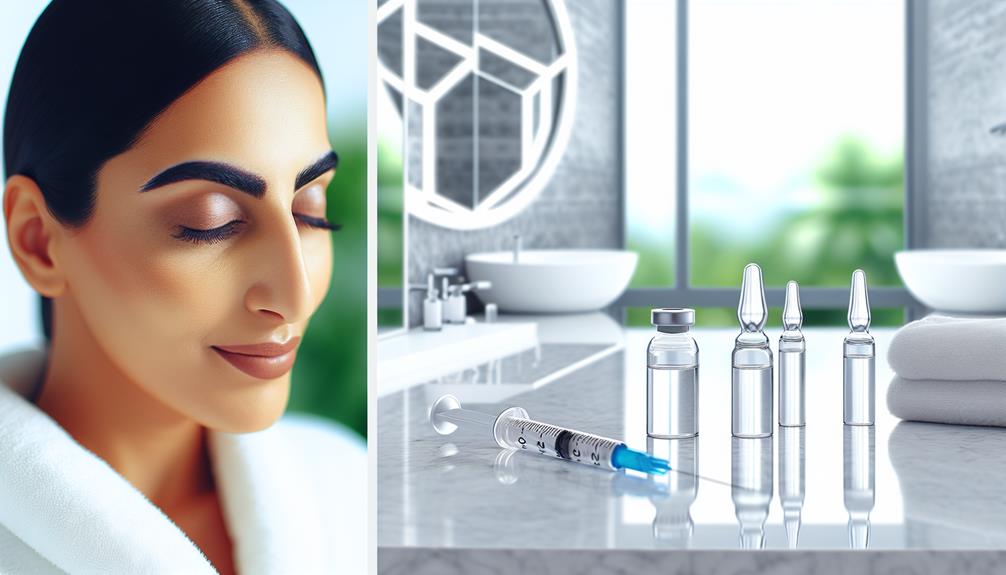
Evaluating the options for under-eye rejuvenation requires a careful consideration of various factors that influence the decision-making process. First and foremost, individuals should assess their personal budget, as the cost of under-eye fillers can vary considerably depending on the provider and geographic location. It's important to balance affordability with the quality of care, ensuring that the chosen practitioner is both experienced and reputable.
Additionally, treatment expectations play an important role in making an informed decision. Prospective patients must realistically evaluate what under-eye fillers can achieve, understanding that while they can considerably reduce the appearance of dark circles and hollows, they are not a permanent solution.
Understanding the longevity of results and potential side effects is crucial for aligning expectations with reality. Engaging in thorough research and consultations with qualified professionals can provide clarity. Ultimately, the decision should be based on a thorough understanding of personal financial parameters and a clear vision of desired outcomes, fostering a sense of empowerment in the journey towards rejuvenation. Making informed choices not only enhances satisfaction but also cultivates a sense of belonging within a community that values self-care and aesthetic enhancement.
Frequently Asked Questions
How Long Do Under-Eye Fillers Typically Last?
Under-eye fillers typically exhibit a filler longevity ranging from six months to two years, depending on factors such as the type of filler used and individual metabolism. Treatment frequency is also influenced by personal aesthetic goals and the degree of volume loss. Regular consultations with a qualified practitioner can help determine the ideal timing for maintenance treatments, ensuring that results remain natural and rejuvenating while fostering a sense of belonging within the community of aesthetic enthusiasts.
Are There Any Age Restrictions for Receiving Under-Eye Fillers?
Age considerations for receiving under-eye fillers typically emphasize that individuals should be at least 18 years old, as this is generally when cosmetic procedures can be legally administered. However, safety guidelines suggest that older adults may also benefit, provided they are in good health. Consulting a qualified practitioner is essential to assess individual needs, as factors such as skin quality and overall health play a significant role in determining eligibility for treatment.
Can Under-Eye Fillers Be Reversed if I'm Unhappy?
Under-eye fillers can indeed be reversed if a patient is dissatisfied with the results. The primary method for reversal involves the use of hyaluronidase, an enzyme that dissolves hyaluronic acid fillers. However, potential filler complications may arise during this process, necessitating a thorough consultation with a qualified practitioner. Ultimately, patient satisfaction is paramount, and understanding the options for reversal can empower individuals to make informed decisions about their aesthetic choices.
Do Under-Eye Fillers Require Downtime After Treatment?
Under-eye fillers typically require minimal downtime, although individual experiences may vary. Most patients can resume normal activities almost immediately, but it is advisable to follow specific aftercare tips, such as avoiding strenuous exercise and excessive sun exposure for a few days. Potential side effects, including swelling and bruising, may occur, but these usually subside within a week. Consulting with a qualified practitioner can provide personalized guidance to guarantee ideal recovery.
What Type of Filler Is Best for Under-Eye Treatment?
When considering under-eye treatment options, hyaluronic acid fillers, such as Restylane and Juvederm, are often recommended due to their natural appearance and reversible nature. These filler types provide hydration and volume, effectively reducing dark circles and hollows. For patients seeking a longer-lasting solution, calcium hydroxylapatite fillers may also be effective. It is essential to consult with a qualified practitioner to determine the most suitable option based on individual needs and desired outcomes.

